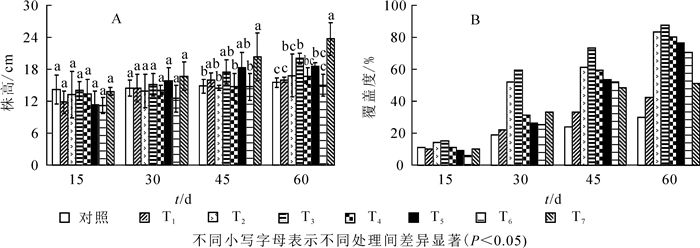-
屋顶绿化是指在脱离自然土壤的各类建筑物和构筑物上,根据其结构特点、荷载要求和生态环境条件,选择合适的植物材料,通过一定的技艺建造绿色景观的形式[1-2]。屋顶绿化的应用为解决城市绿化用地资源紧缺,改善城市生态环境提供了良好的途径[3]。基质是屋顶绿化的重要组成部分,在屋顶特殊条件如荷载、日照、风等因子的限制下[4],要求具有质地轻、持水透气性好、结构和性能稳定、经济环保等特征,为植物的生长提供水、肥、气、热条件,满足植物的正常生长需求[5]。屋顶绿化基质主要有有机基质、无机基质及混合基质等。有机基质为植物提供生长所需的营养物质、促进土壤生物多样性及其相关功能,主要如草炭,有机废弃物堆肥等[6-7];无机基质则为植物提供生长支撑并减少植物受到外界不良环境(如风、温差变化等)的影响,主要由轻质多孔的自然矿物质(浮石、火山灰等)和人为加工材料(膨胀黏土、膨胀页岩等)组成[7]。近年国外在屋顶绿化基质材料的应用侧重于固体废弃物的循环再利用,在建筑垃圾(碎砖、碎瓦、石灰石、黏土等)和有机废弃物(园林绿化废弃物、废纸等)的研究上取得了较好的效果[8-9]。中国的屋顶绿化基质仍选取草炭与其他基质如珍珠岩、椰糠、蛭石等混合配制成的传统草炭基质。随着生态文明和可持续发展要求的提出,寻求草炭的替代基质已成为近年的研究热点[10-11]。现有报道大多为实验室或苗圃盆栽条件下得到的基质配方,缺乏实际应用验证。本研究在屋顶环境下自制模拟槽结构,应用绿化废弃物堆肥逐步替代草炭与无机基质组合配制屋顶绿化基质,通过基质性质检测,屋顶绿化栽植试验植物生长指标观测,综合评价得出质量高、适合简单式屋顶绿化植物生长的基质配方,在促进绿化废弃物资源化利用的同时,也为绿化废弃物堆肥在屋顶绿化基质的应用提供技术参考。
HTML
-
试验地位于北京林业大学西配楼楼顶(40°00′N,116°20′E),楼顶高11.4 m,总面积为50 m × 15 m,绿化面积350 m2;为典型北温带半湿润大陆性季风气候,夏季高温多雨,冬季寒冷干燥,春、秋短促;降水季节分配不均,全年降水量的80%集中在夏季,年均降水量约600 mm,年均太阳辐射量112~136 kcal·cm-2。本研究在4 m × 10 m的空地上进行,试验选用的植物材料为佛甲草Sedum lineare和三七景天Sedum aizoon幼苗(摘心处理)均购自北京花卉市场,长势一致,苗龄1 a,高度(7 ± 1)cm。
试验用屋顶绿化模拟槽尺寸为55 cm × 31 cm × 18 cm,底部带排蓄水板(高2 cm),单侧距离盒底0.5 cm处有1个内径1 cm的排水口。
试验基质材料包括绿化废弃物堆肥、草炭、蛭石和火山岩。绿化废弃物堆肥为腐熟堆肥,由北京地区绿化过程中修剪下来的树枝风干粉碎成5.0 mm以下的固体颗粒,通过条垛式堆肥方法制成;草炭粒径0.2~5.0 mm,蛭石粒径1.0~3.0 mm,火山岩粒径3.0~6.0 mm,以上3种基质材料均购自北京花卉市场。基质材料理化性质见表 1。将基质材料按照一定的体积比混合,以V(草炭):V(无机基质)=1:1为对照,各处理组基质配比如表 2。其中无机基质配比为V(蛭石):V(火山岩)=2:3。
材料 容重/ (g·cm-3) 孔隙度/% pH值 σ/ (mS·cm-1) 阳离子交换量/(cmol·kg-1) w有机质/ (g·kg-1) w全氮/ (g·kg-1) w全磷/ (g·kg-1) w全钾/ (g· kg-1) 绿化废弃物堆肥 0.51 ± 0.02 63.10 ± 0.72 7.50 ± 0.10 3.81 ± 0.47 57.01 ± 5.78 246.67 ± 17.91 10.03 ± 1.61 3.42 ± 0.16 18.17 ± 1.34 蛭石 0.30 ± 0.03 62.73 ± 0.55 7.30 ± 0.00 0.10 ± 0.01 32.38 ± 6.52 1.16 ± 0.23 0.01 ± 0.01 0.84 ± 0.10 33.03 ± 1.70 火山岩 0.76 ± 0.01 51.60 ± 5.48 8.50 ± 0.20 0.13 ± 0.03 25.69 ± 5.44 4.72 ± 4.55 0.12 ± 0.11 0.68 ± 0.03 9.47 ± 0.38 草炭 0.35 ± 0.03 68.20 ± 1.20 4.90 ± 0.10 0.65 ± 0.07 71.05 ± 0.88 378.07 ± 33.48 12.69 ± 0.82 0.99 ± 0.03 10.10 ± 0.44 Table 1. General physical and chemical properties of substrate materials
处理组 V草炭:V绿化废弃物堆肥:V无机基质 对照 50:0:50 T1 35:15:50 T2 20:30:50 T3 0:80:20 T4 0:65:35 T5 0:50:50 T6 0:35:65 T7 0:20:80 Table 2. Ratio of the substrates
-
试验模拟简单式屋顶绿化试验,真实楼顶环境下栽植佛甲草和三七景天幼苗,种植构造层从上至下依次为植被层、基质层、隔离过滤层(2 mm土工布)、排(蓄)水层以及侧面排水口。根据北京地区的气候特点,基质厚度均设置为13 cm。处理组栽植佛甲草和三七景天幼苗各2盆,株间距为13 cm × 14 cm,种植8株·盆-1。实验前3 d每天浇足水(约3 L·箱-1),实验开始后每周浇1次水(约1.5 L·箱-1);期间由专人负责管理,每月月初除草1次,试验期间除虫1次,每组药剂和药量保持一致。不施肥。
-
随机取样测定基质的各项理化指标,重复3次·组-1。物理指标包括干容重、湿容重、总孔隙度、非毛管孔隙度和毛管孔隙度,用环刀法测定。化学指标包括pH值、电导率(EC)、阳离子交换量(CEC)、有机质、全氮、全磷和全钾质量分数;pH值、EC值(水样比5:1)分别用pHB-3pH计及5021电导率仪测定,全氮、全磷质量分数用全自动化学分析仪测定,CEC值、有机质和全钾质量分数参照《土壤农化分析》方法测定[12]。
-
从植物缓苗期(7 d)之后隔15 d测定1次植物的生长指标。从2个模拟槽中随机选取3株进行测定,共测定4次,观测时长60 d。佛甲草的生长指标包括株高和覆盖度,三七景天的生长指标包括生长指数[(株高+最大幅宽+垂直幅宽)/3][13]、分蘖数和覆盖度。其中株高、幅宽用钢卷尺测定,分蘖数通过数数法测定,覆盖度通过拍照法和AutoCAD2007软件计算面积。
-
通过隶属度函数X(f)=(X-Xmin)/(Xmax-Xmin),得到综合评价指数P=(1/f)/(X1+X2+…+Xf);其中X表示某一指标测定值,Xmin表示该指标测定的最小值,Xmax表示该指标测定的最大值,X(f)表示第f个指标的隶属函数值。P值越大,植物生长越好,说明基质配方对植物生长效果越佳。
-
用Excel进行数据处理和作图,用SPSS 22.0对试验数据进行统计分析和差异性显著检验。
1.1. 试验材料
1.2. 试验方法
1.3. 测定指标及方法
1.3.1. 各处理基质理化性质的测定
1.3.2. 佛甲草、三七景天生长指标的测定
1.3.3. 植物指标综合评价
1.4. 数据分析
-
屋顶荷载条件的限制要求基质干容重为0.20~0.80 g·cm-3[14],湿容重为0.45~1.30 kg·m-3[2]。从表 3可以看出:实验组的干容重为0.55~0.69 g·cm-3,湿容重为1.19~1.26 g·cm-3,满足要求。总孔隙度由非毛管孔隙度和毛管孔隙度组成,非毛管孔隙度反映了基质的通气性,毛管孔隙度反映了基质的持水性,与对照组相比,处理组总孔隙度、毛管孔隙度分别减少了3.6%~17.6%和1.4%~25.0%,非毛管孔隙度则呈现不同程度的增加或减少,说明传统草炭基质的综合持水通气性较好,优于处理组。
处理组 干容重/(g·cm-3) 湿容重/(g·cm-3) 总孔隙度/% 非毛管孔隙度/% 毛管孔隙度/% 对照 0.50 ± 0.02 e 1.13 ± 0.01 e 62.57 ± 1.02 a 2.83 ± 1.63 b 59.73 ± 1.62 a T1 0.59 ± 0.06 cd 1.19 ± 0.05 cd 60.30 ± 1.75 abc 3.23 ± 0.65 b 57.13 ± 1.56 ab T2 0.62 ± 0.01 cd 1.21 ± 0.01 bc 59.50 ± 0.36 bc 1.87 ± 1.58 b 57.53 ± 1.12 ab T3 0.57 ± 0.02 d 1.19 ± 0.01 cd 61.97 ± 0.67 ab 3.10 ± 1.55 b 58.87 ± 1.56 a T4 0.65 ± 0.03 ab 1.26 ± 0.01 a 61.17 ± 2.05 ab 3.57 ± 1.15 b 57.60 ± 1.38 ab T5 0.65 ± 0.01 ab 1.23 ± 0.01 ab 58.07 ± 0.78 c 3.53 ± 1.50 b 55.53 ± 1.07 b T6 0.68 ± 0.01 a 1.20 ± 0.01 bcd 51.57 ± 2.35 d 6.80 ± 2.50 a 44.77 ± 4.55 d T7 0.65 ± 0.03 abc 1.16 ± 0.10 d 52.97 ± 2.25 d 2.70 ± 1.15 b 50.27 ± 1.60 c 说明:同列不同字母代表处理间差异显著(P<0.05) Table 3. Physical properties of different substrates
一般而言,偏中性的土壤条件更适合植物的生长。从表 4可以看出:除对照组和T1组土壤呈酸性外,其余各组呈中性或者弱碱性,且随着对照组中草炭被绿化废弃物堆肥逐渐替代其pH值随之增大,说明绿化废弃物堆肥的添加能改良传统草炭基质的酸碱性。处理组EC值显著高于对照组(0.34 mS·cm-1),T3组最高,为2.28 mS·cm-1,T3~T7组EC值逐渐降低,说明EC值随绿化废弃物堆肥的增加显著增大,与胡嘉伟等[15]的研究结果一致。但过量的绿化废弃物堆肥可能会导致土壤盐碱化,需添加EC值较低的基质降低其电导率。
处理组 pH值 σ/(mS·cm-1) 阳离子交换量/(cmol·kg-1) w有机质/(g·kg-1) w全氮/ (g·kg-1) w全磷/(g·kg-1) w全钾/(g·kg-1) 碳氮比 对照 5.70±0.10 f 0.34±0.03 g 54.95±7.17 a 255.23±19.77 a 5.38±1.14 c 0.91±0.06 d 11.70±0.44 cd 28.02±3.67 a T1 6.40±0.23 e 0.83±0.24 e 50.22±4.86 ab 174.52±13.42 bc 7.14±1.09 ab 1.21±0.21 cd 10.23±0.32 d 14.37±2.25 cd T2 7.00±0.06 d 1.06±0.05 d 43.18±3.91 bc 168.99±3.04 bc 5.77±0.44 bc 2.73±1.86 a 14.43±1.75 abc 17.09±1.62 bc T3 7.40±0.06 c 2.28±0.24 a 44.36±1.28 bc 194.80±19.51 b 7.97±0.74 a 2.61±0.19 ab 14.90±0.61 ab 14.21±1.30 cd T4 7.40±0.06 c 1.94±0.07 b 45.57±1.54 bc 145.67±26.28 cd 7.65±0.81 a 2.54±0.11 abc 14.07±2.76 abc 11.06±1.80 d T5 7.50±0.00 bc 1.33±0.03 c 39.18±3.78 c 124.74±8.20 d 3.81±1.19 d 1.92±0.41 abcd 15.73±0.93 a 20.35±6.33 b T6 7.60±0.06 ab 0.72±0.12 ef 26.91±4.13 d 76.73±18.42 e 2.36±0.60 de 1.58±0.44 abcd 12.57±2.00 bcd 18.89±0.26 bc T7 7.80±0.06 a 0.54±0.04 fg 24.57±1.71 d 74.39±12.37 e 2.03±0.58 e 1.32±0.08 bcd 15.33±1.07 ab 21.87±3.43 b 说明:同列不同字母代表处理间差异显著(P<0.05) Table 4. Chemical properties of different substrates
阳离子交换量(CEC)反映了基质的保肥性,其值越高保肥性越好。与对照组相比,绿化废弃物堆肥和草炭配比降低了基质的CEC值,随着绿化废弃物堆肥的增加,T3~T7组CEC值总体呈上升趋势,且在绿化废弃物堆肥体积比为50%前后差异显著,低于50%或高于50%时则无显著差异,说明有机基质草炭的保肥能力较绿化废弃物堆肥要强,且若只考虑CEC指标,在绿化废弃物堆肥基质配比中可适当降低其质量分数。对照组有机质质量分数显著高于处理组,达到了255.23 g·kg-1,T7组最低,为74.39 g·kg-1,说明就有机质质量分数而言,绿化废弃物堆肥较草炭要低。氮、磷、钾为植物生长所必需的营养元素,三者的供应状态直接影响到植物的产量和质量[16],对比对照组和T5组可以得出,草炭的全氮量较绿化废弃物堆肥多,绿化废弃物堆肥全磷量和全钾量较高,随着绿化废弃物堆肥体积含量的增加,T3~T7组基质全氮、全磷质量分数随之增加,而全钾的变化则相对复杂,可能与蛭石含有较高的钾(表 2)有关,与李燕等[17]的研究结果大体一致,说明绿化废弃物堆肥的氮磷钾养分较草炭更均衡。碳氮比(C/N)反映了微生物的活性,C/N高则需要从外界补充氮素提高微生物的生物活性。由表 3可知:对照组的C/N显著高于处理组,处理组为14~22;受较高的有机质和全氮质量分数的影响,同等条件下,草炭基质具有高碳氮比特性,而绿化废弃物堆肥则具有降低碳氮比的作用。
-
佛甲草为匍匐草本植物,待植物成坪后许多生长指标测定难以进行,因而本研究只选取了株高和覆盖度作为调查指标。从图 1A可以看出:栽植试验的前30 d,各组间佛甲草株高无显著差异;30~60 d对照组几乎没有增长,处理组则出现了明显的增长优势;第60天时,T7组株高明显高于其他组,为23.7 cm,株高从高到低依次为T7,T3,T5,T2,T4,ck和T6。从图 1B可以看出:栽植第15天时,各组覆盖度值相差不大,在10%上下波动,之后对照组缓慢增长;栽植30~45 d,处理组覆盖度呈较快增长,远超对照组;第30天时T3和T2组增长幅度最大且最明显,分别增长了314.28%和271.43%,第60天时,覆盖度从大到小依次为T3,T2,T4(≥80%),T5,T6,T7(>50%),T1,ck。
-
由图 2A可知:栽植时长不同,三七景天生长指数出现波动。15~30 d,T3组生长指数最大,45~60 d,T4组生长指数最大;除在第30天,T7组生长指数最小外,其他时间,对照组生长指数均为最小。整体而言,处理组的生长指数在4个时间段均优于对照组。由图 2B可知:三七景天在栽植第15天时,对照组分蘖数较T3组,T7组存在一定的优势,之后则逐渐落后于各处理组,在栽植第30~45天,处理组分蘖数整体呈较快增长,而对照组在栽植30 d之后分蘖数增长及其缓慢,分蘖能力低。由图 2C可知:在栽植的前30 d内,三七景天对照组覆盖度存在较大的优势,30 d之后其覆盖度增长较缓慢,处理组则一直保持较快的增长速度,在第45~60天,各处理组均大于对照组。
-
本研究通过隶属度函数计算综合评价了不同基质条件下第60天的佛甲草和三七景天生长指标。结果表明(表 5):处理组综合评价系数远大于对照组,其中,T4组综合评价系数最高,为0.80,T2组次之,为0.72,说明此两者为最适宜基质;T3组、T5组的综合评价系数较T6组和T7组大,且从T5组到T6组综合评价系数降低速率最大,为40.7%,说明绿化废弃物堆肥体积比≥50%的混合基质对植物的生长具有明显促进作用,此外,T6组、T7组的综合评价系数亦远大于对照组。
处理组 佛甲草 三七景天 综合评价系数 综合排名 高度/cm 覆盖度/% 生长指数 分蘖数/个 覆盖度/% 对照 0.06 0.00 0.00 0.00 0.00 0.01 8 T1 0.11 0.20 0.19 0.14 0.19 0.17 7 T2 0.21 0.92 0.52 1.00 0.95 0.72 2 T3 0.57 1.00 0.61 0.58 0.81 0.71 3 T4 0.20 0.88 1.00 0.93 1.00 0.80 1 T5 0.41 0.81 0.29 0.79 0.67 0.59 4 T6 0.00 0.80 0.23 0.42 0.29 0.35 5 T7 1.00 0.37 0.00 0.19 0.05 0.32 6 Table 5. Comprehensive evaluation of growth indexes of Sedum lineare and S.aizoon with 60 days' plantation
2.1. 不同配比基质处理理化性质对比分析
2.2. 不同基质对佛甲草幼苗生长的影响
2.3. 不同基质对三七景天幼苗生长的影响
2.4. 不同基质条件下2种植物生长综合评价分析
-
草炭为酸性有机基质,具有质轻、有机质含量高和保肥性强的优点,合理搭配其他基质材料能够满足植物的基本生长需求,在园艺基质中得到了广泛的应用;但草炭为不可再生资源,近年来的大量开采导致其资源应用紧张,寻求其替代基质刻不容缓。本研究发现:与传统草炭基质相比,添加绿化废弃物堆肥的基质满足屋顶绿化基质荷载要求,能较好地改良基质酸碱性,降低碳氮比,均衡氮磷钾养分,对植物中后期生长的促进效果更明显;但是其EC值较高,需通过与其他基质材料混配改良。魏乐等[18]的研究表明:绿化废弃物堆肥能明显改善基质中大量元素和微量元素质量分数,更好地促进植物生长;殷庆霏等[10]则发现添加绿化废弃物堆肥基质对植物株高、叶绿素、净光合速率等指标的促进作用明显优于草炭基质。但是由于原料成分和堆肥工艺等无法统一,当前制作出的绿化废弃物堆肥良莠不齐,因而需要不断实践制订堆肥产品标准。
有机基质和无机基质含量决定了基质的营养成分和矿物成分。基质中有机基质较高易引起荷载过大、细颗粒淀积以及不可预测的生物活性等一系列问题[19]。基质在屋顶上其更换难度和更换成本要明显高于地面,除了满足基本的理化性质外,还要求有较长的使用年限和良好的稳定性。随着时间的推移,有机基质逐渐分解,基质层变薄,合理的有机基质和无机基质配比可以满足高质量、使用年限长的屋顶绿化基质要求。本研究通过屋顶绿化景天科Crassulaceae植物佛甲草、三七景天幼苗栽植试验发现,绿化废弃物堆肥在屋顶绿化应用中比传统草炭基质效果要好,且绿化废弃物堆肥体积比≥50%效果要比体积比<50%好,即有机基质含量高更有利于植物的生长,与李燕等[17]、汤聪等[20]的研究结果一致。在有机基质含量较高(T3)与较低(T2)能取得相同效果的情况下,建议使用有机基质含量较低的配方。本研究中的T6,T7处理组绿化废弃物堆肥体积比<50%,其综合评价系数值较低,但是依然远大于传统草炭基质,若是在后期合理施用,其作为屋顶绿化的理想基质具有较大的潜力。
对屋顶环境条件下景天科植物佛甲草、三七景天部分生长指标的动态监测和综合评价分析显示,T4组和T2组为最适宜配方基质,即V(绿化废弃物堆肥):V(无机基质)=65:35和V(绿化废弃物堆肥):V(草炭):V(无机基质)=30:20:50,其中的无机基质配比为V(火山岩):V(蛭石)=3:2。












 DownLoad:
DownLoad:
